|
|||||
Welcome to the home page of the 1100 mm Cruxis Telescope. This telescope is designed and constructed by the Belgian amateur astronomer Robert Houdart and should see its first light in The actual construction of the telescope started in April 2007, but was interrupted for nearly 4 years because of problems with the production of the cellular mirror blank. After Wangsness went out of business in 2010, it was decided to replace the original cellular blank with a classical, solid Supremax mirror blank. Mike Lockwood delivered the finished 1100 mm mirror in May 2012, and the construction can now continue.
Latest News September 8, 2012: First light for the 1100 mm telescope
It's been a long journey, 4 years longer than planned, but finally we have landed. Installation of the primary mirror
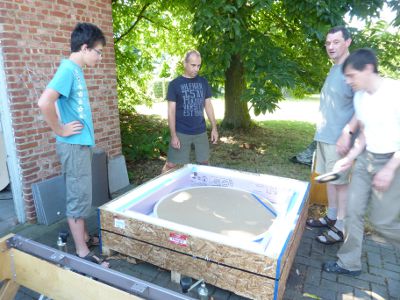 Two weeks ago we installed the 1100 mm primary mirror in its cell; three strong family members helped to lift the
105 kg chunk of glass in the mirror box. The mirror had spent about 3 months in its crate outside in
all kinds of weather (mostly rain as we've had the wettest month of June in over 30 years), so I
wasn't sure what we would find under the cardboard cover taped to the mirror. To my relief the surface
was impeccable. It's quite a sight to see a brand new 1100 mm mirror with absolutely spotless coating,
without even a speck of dust.
Two weeks ago we installed the 1100 mm primary mirror in its cell; three strong family members helped to lift the
105 kg chunk of glass in the mirror box. The mirror had spent about 3 months in its crate outside in
all kinds of weather (mostly rain as we've had the wettest month of June in over 30 years), so I
wasn't sure what we would find under the cardboard cover taped to the mirror. To my relief the surface
was impeccable. It's quite a sight to see a brand new 1100 mm mirror with absolutely spotless coating,
without even a speck of dust.
Friday: Quick first light
The first quick star light was Friday 7th September. The main goal of the session was to locate the
position of the focal plane, to establish accurately the length of the truss tubes. I had cut the truss
tubes about 60 mm too long, so that the focal point was located inside the focuser. A 24 mm Panoptic
fits inside a 2" focuser, and by sliding the eyepiece down you can focus the image. The difference
between measured and computed position was less than 10 mm. Nice!
While doing this test, Arcturus was the first identified star seen in the telescope. I also looked at M27, officially the first deep-sky object observed with the new telescope. Saturday: Real first light
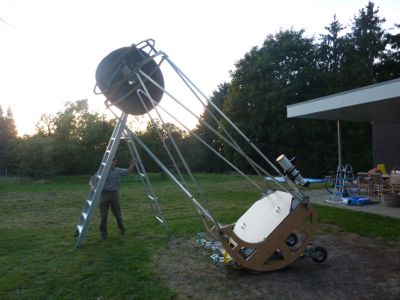 The next day I cut the truss tubes to the correct length, set-up the telescope and performed the first
collimation. A nice finishing touch by Mike Lockwood is that he etches small circles at the exact
center of the mirror - it avoids those awkward moments hanging over the mirror with
a template or a ruler trying to locate the exact center where you're going to attach a marking sticker.
Collimation was straightforward and remained stable at different altitudes. From 15° to 75°
altitude the laser dot on the primary hardly moved - maybe at most a mm. Equally the movement of the
Cheshire reflection was very small, again maybe of the order of a mm. That's not too bad for a 3,950 mm
focal length mobile telescope!
The next day I cut the truss tubes to the correct length, set-up the telescope and performed the first
collimation. A nice finishing touch by Mike Lockwood is that he etches small circles at the exact
center of the mirror - it avoids those awkward moments hanging over the mirror with
a template or a ruler trying to locate the exact center where you're going to attach a marking sticker.
Collimation was straightforward and remained stable at different altitudes. From 15° to 75°
altitude the laser dot on the primary hardly moved - maybe at most a mm. Equally the movement of the
Cheshire reflection was very small, again maybe of the order of a mm. That's not too bad for a 3,950 mm
focal length mobile telescope!
My wife and myself observed a couple of hours from our sub-urban backyard (SQM 19.5). Only a hint of the Milky Way was visible, but still we had great views of the Veil, NGC 604 (the emission region in M33) and especially M27 with the UHC filter was very beautiful.
It's too early to say anything about the optical quality, stars came nicely into focus - but at 350X we're working at "low power" for this telescope. I noticed some astigmatism which is most probably coming from the edge support - in the new arrangement with a single 6 mm cable the edge support may be too flexible. I'll need to find a 10 mm cable or go for a solid 90° edge support. At f/3.6 the Paracorr II makes a world of difference. Comparing the views in the 31 mm Nagler with and without the Paracorr is shocking. I doubt the Paracorr will ever leave the focuser during the observations! On the brightest stars (Arcturus, Vega) the double vanes produce an interesting effect, but otherwise the vanes are hardly noticeable, as expected. With the very stable "Solide" ladder observing at 3+ meter height is no problem whatsoever. Even in this short first session I felt the need for a half-step like I made for the 25" scope. It reduces the ladder rung distance to 12 cm (5") which makes for much more comfortable observing. I'll certainly add this ASAP.
As expected the telescope is bottom-heavy, about 2 kg counterweight has to be added to the upper cage to balance the tube. That's what happens when you design for a focal length of 4400 mm to end up with a focal length of 3950 mm... By using 30x2 mm square truss tubes instead of the current 30x1.5 mm the balance issue would be solved in a useful way, adding some structural stiffness. The Megrez 110 telescope acts as a finder, with a 28 mm UWAN eyepiece delivering 23X and a 3.5° field
that is tack-sharp to the edge. It's exactly 10 times smaller than the main telescope, and is the same
size as the 4.5" Newtonian I used for nearly a decade in the 1980s. I'm very happy with the 30 years of progress :).
July 1, 2012: First assembly
The telescope is now nearly finished, everything has been adapted to the new configuration with solid
disk f/3.6 mirror. All the wooden parts have been finished with 3 coats of high-quality
stain, and we're now preparing for putting the optics in the telescope.
Yesterday we made the first assembly of the final telescope without optics, below some pictures of the occasion. During assembly the telescope is kept in a horizontal position with a winch, so that you can keep your feet safely on the ground. First a light-weight ring is attached to the truss tubes, then the complete upper cage.
Tourism of the Deep Sky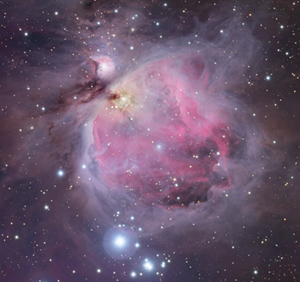
After having constructed a 406 mm (16") scope in 1990 and a 635 mm (25") in 2000-2002, I naturally wanted to move on. Since 2005 I've been contemplating the "next" telescope. I finally decided to go for the biggest scope I could fund and manage by myself, which turned out to be 1100 mm (43"). The Cruxis Telescope will become one of the largest portable amateur telescopes in the world, together with Erhard Hänssgen's 107 cm Dobson (42") and Dan Bakken's 41.2" Hercules (1046 mm). What drives me in this venture is the extra-ordinary splendor of the universe one can experience at the eyepiece. Objects like the Orion Nebula, the Whirlpool Galaxy or the Veil Nebula are beautiful beyond description in large telescopes. Photographs simply do not do justice to the visual thrill at the telescope eyepiece (although they may show a lot more details than you could ever see visually). The best description of my favorite hobby would be "tourism of the deep sky". Design Criteria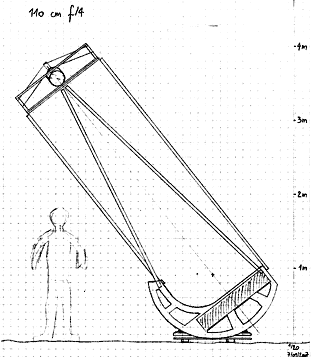
Optics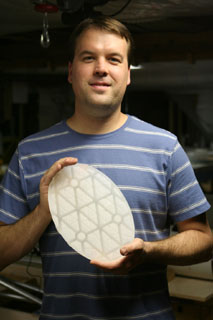
Mike Lockwood will take on the challenge to produce the optics for the Cruxis telescope project. Mike is an experienced and well known amateur telescope maker who has transited into custom, high-quality professional optical work for mirrors up to 50" (127 cm). The picture on the right shows Mike holding the secondary mirror blank at its arrival in October 2007. To reduce weight and improve the cooling time of the optics, both the primary and secondary mirrors will be cellular. The cellular mirror blanks are designed and cast by Wangsness Optics. I will validate the cellular designs of the mirrors by finite element analysis. The optical surface of the primary mirror will be approx. 15 mm (5/8") thick, its total thickness about 185 mm (7.3"). More information about the cellular design of the 120 kg (260 lbs) primary mirror will follow later. The Secondary Mirror Design page contains more information about the 1.9 kg (4.3 lbs) secondary mirror. Delivery of the finished optics is scheduled for April 2008. Construction
Some Facts and Figures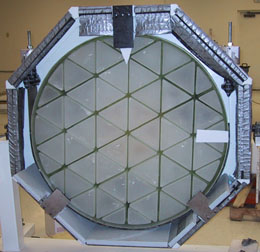
Mechanical Design
Design and Construction History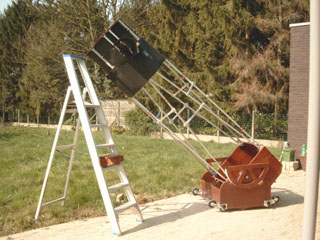 The construction of the 1100 mm telescope has been a 6 year voyage with some very good and some very
bad moments.
The construction of the 1100 mm telescope has been a 6 year voyage with some very good and some very
bad moments.
The key events:
You can click here to view the full history of the Cruxis telescope. Personal Telescope History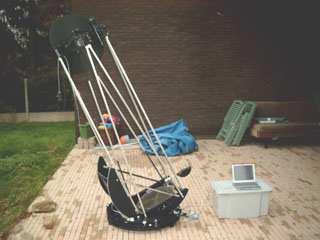
Professional Background
From 1991 to 1999 I was employed by Tractebel Engineering to analyze earthquake and impact resistance of nuclear piping systems. Since 1999 my main activity has been the design and development of two web-based CRM applications: first eLink, and since 2005 Efficy. The latter application has been selected by the IT magazine Data News as one of the "Top 10 Products for 2006". Since 2009 I've also created the Chess Engine Houdini, currently the strongest chess engine in the world. If you're interested, see the Houdini Chess Engine page. Houdini got created during the long and fruitless wait for the cellular mirror of the 1100 mm telescope :). | |||||
|
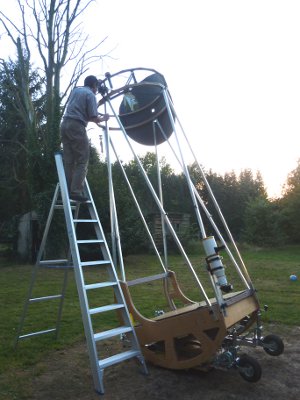
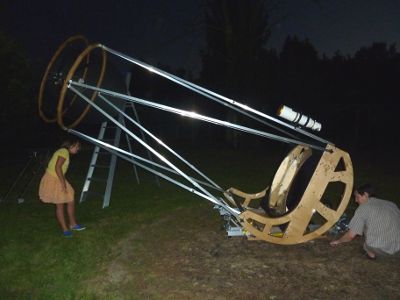
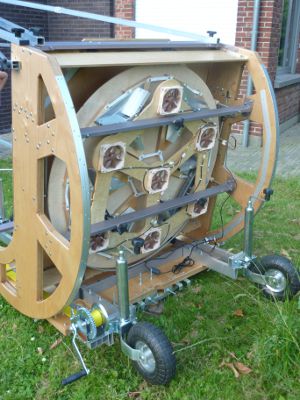

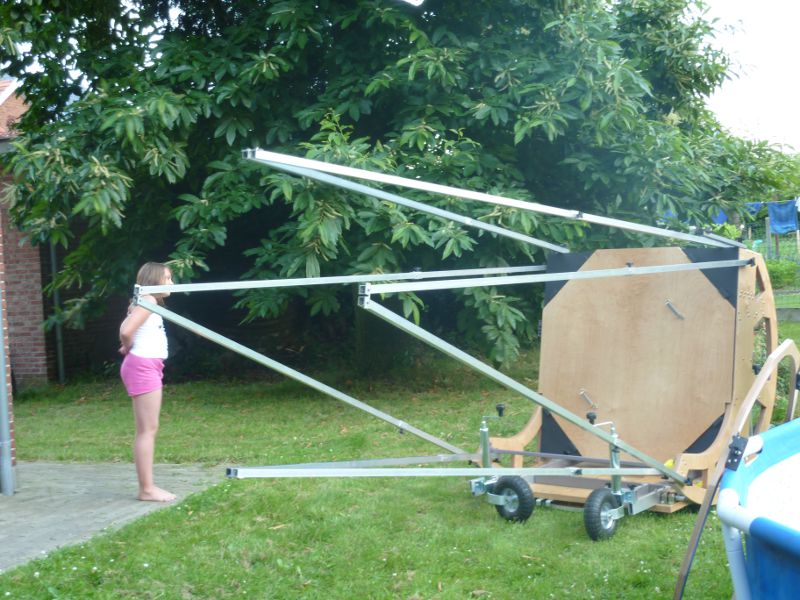

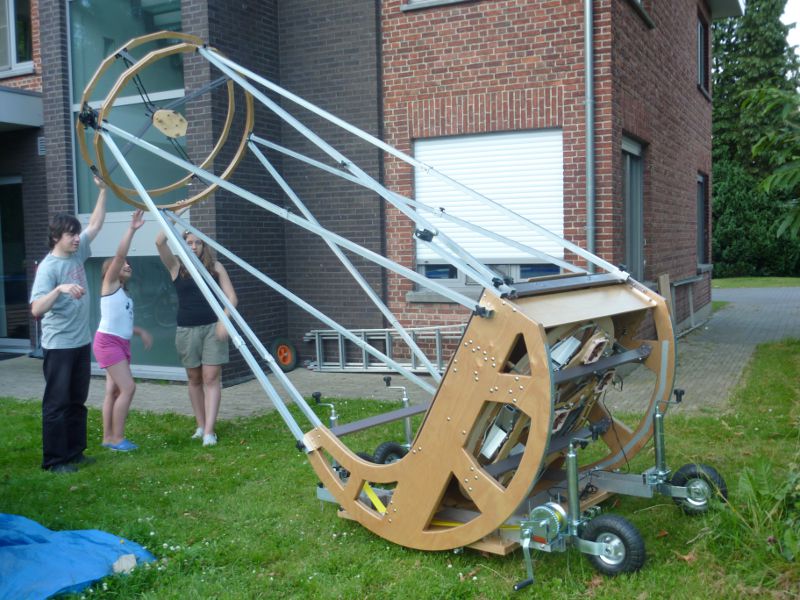
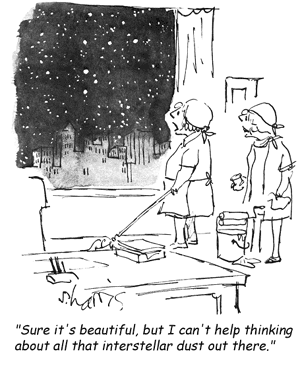 Visual observing only
Visual observing only